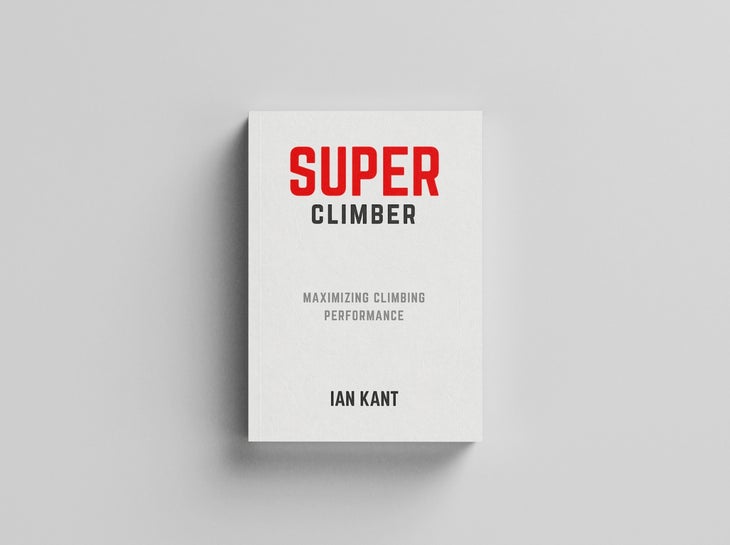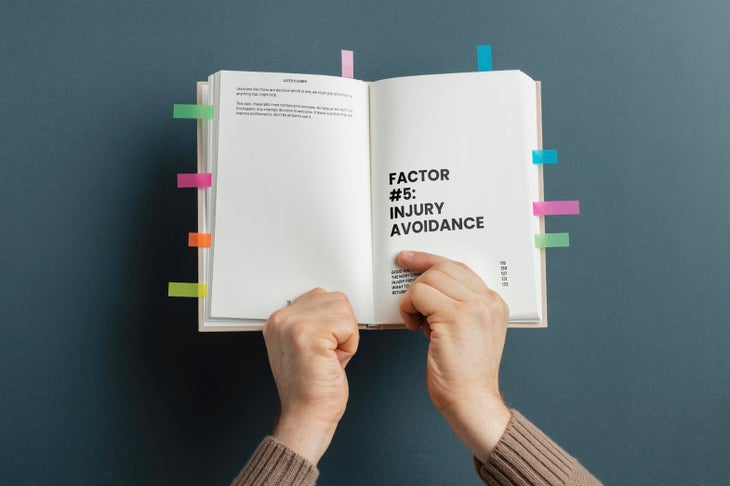What Ondra and Puccio Do Won’t Work for You (And Other Training Tips!)

The following is an excerpt from Super Climber: Maximizing Climbing Performance, by Ian Kant and translated by Christopher Schafenacker. How do you actually get better at climbing, and, more specifically, how should you adjust your climbing practice so as to achieve your personal goals? This book looks at the research and distills it to easy-to-apply training tips and offers an an in-depth study of specific, structured programing.

CHECK OUT THE BOOK HERE
Part Three: Training Determining Factors of Performance
Though we will say more about each of these aspects later, we begin by highlighting some of the ideas that matter most to structuring an effective training plan.
Don’t do what others do.
Especially where the best climbers in the world are concerned.
What Ondra or Puccio does won’t work for you.
Emulating what elite climbers do makes no sense. We’re talking about athletes with more than 20 years of experience and enormous levels of specific strength who follow routines that for the rest of us would be impossible.
This is why Adam Ondra refuses to give interviewers details about his training (load, intensity, etc.). In his own words, “if someone does what I do, they’ll get injured.”
Many people watch videos of the pros for the wrong reasons. They watch hoping to replicate their exercises and routines when they should be looking to replicate their technique, movement, rhythm, and resting patterns.
We must learn to see their precision, control, determination, and resolve.
Don’t believe everything you hear.
In climbing, anyone who climbs better than you will spray you down with well-intended advice. People with no training or qualifications will tell you what to eat (as if they were dieticians), how to recover from injury (as if they were orthopedic surgeons), how to tape your fingers (as if they were physiotherapists), will explain the mechanics of a move (as if they were trained in sports biomechanics), give you lessons in psychology, conditioning, load, intensity, periodization, etc., etc., etc. without the least bit of formal training.
Don’t listen to those who simply climb harder than you.
Think critically about the information you receive and the source providing it. Being a YouTuber with many followers doesn’t make you an expert. Where the specifics of climbing are concerned, consult qualified coaches (with degrees) and don’t let even them become your doctor, dietician, and so on.
Never push yourself to the point of extreme fatigue.
Good training is about efficiency, not about working your muscles to their breaking point. In climbing, “no pain, no gain” is often misunderstood to mean high training volumes (thousands of moves with no purpose). Not only is this counterproductive to skills development, but it is also an easy way to get injured.
Climbing is governed by an alternate principle: “No brain, no gain.”
Try hard but smart.
What follows is a study of training components and principles that provide a basis for understanding how we can improve as climbers.
What is Training?
Training is a process of physical, technical, and mental transformation achieved through the application of external loads with the aim of improving performance.
Upon the basis of this definition, we analyze its component parts.
Training is a process; that is, a series of steps, a set of successive stages occurring over time. You don’t train by just heading to the climbing gym one day or spontaneously going climbing outdoors. Training is cyclical and periodic.
We talk of transformation because training involves an initial and final stage. Climbing demands physical, technical, and mental changes and so it is incomplete to speak just of physical improvement.
Moreover, adequate loads, volume, and intensity are required to generate wear, provoke muscular supercompensation, and improve other factors. Performing easy moves on some wall or rock is not enough.
Finally, this process must lead to higher levels of performance. We must improve, send harder routes, and increase our skill level. Climbing training is not about doing exercises that do not improve our specific capabilities.
Components of Training
Component #1: Physical Activity
Component #2: Recovery/Silent Training
When we talk about training, we tend to think of exercises in a gym or on rock but this notion is incomplete.
Training has two inexorable components upon whose interrelation improvement depends: (1) physical activity and (2) rest.
Component #1: Physical Activity
This component refers to physical exercise itself. Despite the name, it’s not just about working on physical capacities such as strength but must also integrating technical skills (movement, body positioning, etc.) and mental skills (activation, memory, etc.).
These things can be trained indoors at a climbing gym, as is most often the case, or outdoors on real rock.
Get Swole Faster with these Science-Backed Training Protocols
Training is not about strict repetitions, controlled loads, and timing yourself with a stopwatch but about incorporating all of the definitional elements mentioned above.
Many achieve this by simply getting out to climb. They are aware of the process, they provoke physical, technical, and mental transformations, they engage increasing loads by trying progressively harder lines, and they achieve the goal of improving.
A notable example of this is Chris Sharma who in his early career was confined to a climbing gym but who later devoted himself exclusively to rock. This became especially true after he settled permanently in Spain in 2007 and it did not prevent him from taking his training outdoors and sending Jumbo Love at Clark Mountain, USA (2008), the first 9b (5.15b) in history nor La Dura Dura 9b+ (5.15c) in 2013. This has also been Dani Andrada’s, José Luis Palao “Primo”’s, and many others’ approach, all of whom have managed to improve climbing only on rock.
Now, not just any physical activity counts as training for climbing.
As we’ve already seen, running, cycling, or yoga don’t help. Climbing is what makes us better climbers which brings us to training’s biggest secret.
The best training for climbing is climbing, itself.
Training is often dissociated from actual climbing when they are really one and the same. Training is climbing.
The only way to improve as a climber is to climb.
Campus boarding and pull-ups may make you stronger, but they won’t make you a better climber. Strength gains achieved will need to be “transferred” to climbing. In contrast, anything you gain from climbing, itself, will require no transfer.
This brings us to another essential, already noted distinction. Anything that is not climbing is complementary, extra, or supplemental. It’s like taking a multivitamin: a good supplement but never a replacement for a healthy, balanced meal.
There are no exercises or routines that make us better climbers. When considering such exercises, then, we should ask:
What can this exercise do for me that climbing can’t?
Finger strength training on a hangboard is perhaps the only case that presents a comparative advantage.
The reason here is that both climbing and hangboarding involve isometric contractions (the fingers engage without moving). That is, both cases involve the same action.
Hangboarding allows controlled, isolated, consistent, and easily measurable finger strength training. Maintaining a high degree of control over the training stimulus facilitates greater precision in manipulating variables which results in more improvement over less time and a smaller risk of injury.
Nonetheless, hangboarding will not provide all the benefits of actual climbing (especially if you are a beginner or intermediate).
Thus, climbing, itself, is always the best way to make gains in our sport’s various performance factors.
Understanding this confirms that looking for a “miracle exercise” (a magic potion) to take you to the next level is a mistake. No such exercise exists because climbing strength is the result of thousands of structures working together in technical coordination to produce complex movements.
If complementary exercises are not as useful as often thought, why do experienced climbers devote many hours to such routines?
Complementary exercises provide the strength needed to tolerate higher loads.
A stronger body will withstand higher loads while climbing. Stronger muscles are able to work at higher intensity for longer.
Thus, the relationship between complementary exercises and climbing level is indirect rather than direct. Better physical conditioning allows us to withstand higher intensity climbing which in turn leads to improvement.
Complementary exercises prevent injury.
No doubt, complementary exercises strengthen the body. This does not impact the strength factor of performance (because this strength is specific) so much as the injury prevention factor.
Being clear on this implies a shift in perspective regarding the purpose of doing these exercises. Lifting weights, doing pull-ups, TRX and ring training, etc. doesn’t make us better climbers but conditions our body to be able to improve while climbing.
In short, such training helps you get the most out of your climbing sessions by increasing your body’s ability to withstand greater intensity.
However, it can also be a distraction, can consume time better spent climbing, and can deplete your ability to recover resulting in reduced performance and possible injury.
Supplemental strength training is seductive because progress is easy to measure. However, if you want to improve you can’t lose sight of the fact that the principal aim lies elsewhere.
CHECK OUT THE BOOK HERE



The post What Ondra and Puccio Do Won’t Work for You (And Other Training Tips!) appeared first on Climbing.

